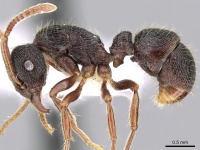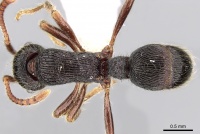Holcoponera pittieri
| Holcoponera pittieri | |
|---|---|

| |
| Scientific classification | |
| Kingdom: | Animalia |
| Phylum: | Arthropoda |
| Class: | Insecta |
| Order: | Hymenoptera |
| Family: | Formicidae |
| Subfamily: | Ectatomminae |
| Tribe: | Ectatommini |
| Genus: | Holcoponera |
| Species: | H. pittieri |
| Binomial name | |
| Holcoponera pittieri (Lattke, 1990) | |
Hypogeic leaf litter (including bamboo) dweller of cloud forests of the Venezuelan Cordillera de la Costa.
Identification
A member of the strigata complex (in the strigata subgroup of the striatula species group). Sculpture with rough aspect; frontal lobes each with a median emargination; eyes protuberant and subglobular; propodeal spiracles rnounted at the apex of protuberances. A series from near Tejerias differs from the type series in having the notch on the frontal lobes shallower, the propodeal spiracles on higher turrets, finer costulae on the anterior postpetiolar face and metacoxal spines more acute. (Lattke 1995)
Keys including this Species
Distribution
Latitudinal Distribution Pattern
Latitudinal Range: 10.35944444° to -1.767008°.
| North Temperate |
North Subtropical |
Tropical | South Subtropical |
South Temperate |
- Source: AntMaps
Distribution based on Regional Taxon Lists
Neotropical Region: Venezuela (type locality).
Distribution based on AntMaps
Distribution based on AntWeb specimens
Check data from AntWeb
Countries Occupied
| Number of countries occupied by this species based on AntWiki Regional Taxon Lists. In general, fewer countries occupied indicates a narrower range, while more countries indicates a more widespread species. |

|
Estimated Abundance
| Relative abundance based on number of AntMaps records per species (this species within the purple bar). Fewer records (to the left) indicates a less abundant/encountered species while more records (to the right) indicates more abundant/encountered species. |

|
Biology
Castes
Nomenclature
The following information is derived from Barry Bolton's Online Catalogue of the Ants of the World.
- pittieri. Gnamptogenys pittieri Lattke, 1990b: 18, fig. 11 (w.q.) VENEZUELA.
- Type-material: holotype worker, 1 paratype worker, 1 paratype queen.
- Type-locality: holotype Venezuela: Estado Aragua, Parque Nacional Henri Pittier, Rancho Grande, 10°21’N, 67°41’W, 1400 m., 20.x.1981 (C. Bordón); paratypes with same data.
- Type-depositories: MIZA (holotype); MIZA, MZSP (paratypes).
- Combination in Holcoponera: Camacho, Franco, Branstetter, et al. 2022: 11.
- Status as species: Brandão, 1991: 345; Bolton, 1995b: 210; Lattke, 1995: 179; Lattke, et al. 2007: 259 (in key); Camacho, et al. 2020: 456 (in key); Camacho, Franco, Branstetter, et al. 2022: 11.
- Distribution: Ecuador, Venezuela.
Description
References
- Camacho, G.P., Franco, W., Branstetter, M.G., Pie, M.R., Longino, J.T., Schultz, T.R., Feitosa, R.M. 2022. UCE phylogenomics resolves major relationships among Ectaheteromorph ants (Hymenoptera: Formicidae: Ectatomminae, Heteroponerinae): A new classification for the subfamilies and the description of a new genus. Insect Systematics and Diversity 6(1): 5; 1–20 (doi:10.1093/isd/ixab026).
- Cantone S. 2018. Winged Ants, The queen. Dichotomous key to genera of winged female ants in the World. The Wings of Ants: morphological and systematic relationships (self-published).
- Lattke, J. E. 1990b. Revisión del género Gnamptogenys Roger en Venezuela (Hymenoptera: Formicidae). Acta Terramaris 2: 1-47 (page 18, fig. 11 worker, queen described)
- Lattke, J.E., Fernández, F. & Palacio, E.E. 2007. Identification of the species of Gnamptogenys Roger in the Americas (pp. 254-270). In Snelling, R.R., Fisher, B.L. & Ward, P.S. (eds). Advances in ant systematics: homage to E.O. Wilson – 50 years of contributions. Memoirs of the American Entomological Institute 80: 690 pp.
- Lattke, J. E. 1995. Revision of the ant genus Gnamptogenys in the New World (Hymenoptera: Formicidae). J. Hym. Res. 4: 137-193. PDF
References based on Global Ant Biodiversity Informatics
- Fernández, F. and S. Sendoya. 2004. Lista de las hormigas neotropicales. Biota Colombiana Volume 5, Number 1.

